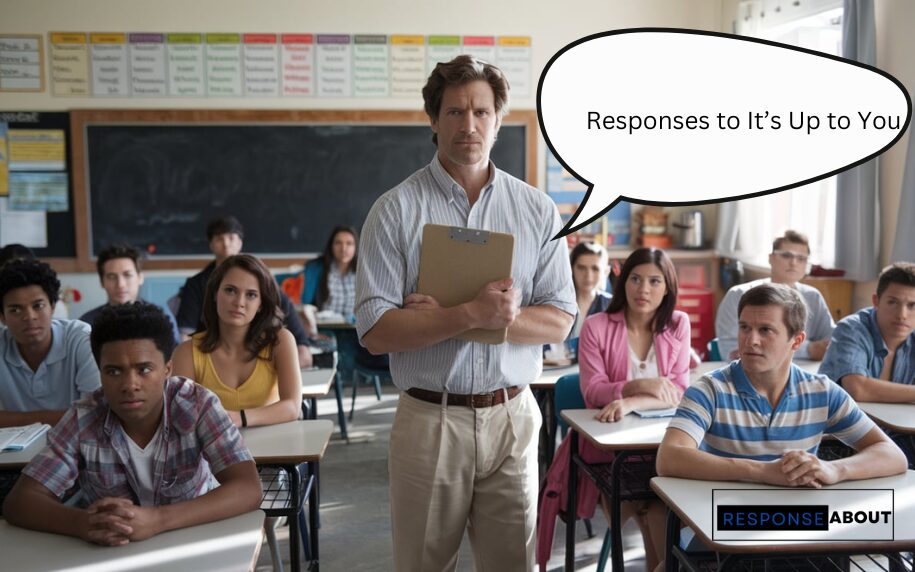Last month, my friend and I were trying to decide where to eat dinner. After suggesting a few restaurants, she finally said, “It’s up to you.” I froze—was she genuinely flexible, or was this a test where my choice would somehow be wrong? I awkwardly responded with, “No, really, you choose,” and we entered that frustrating loop of indecision that wasted 20 minutes before we finally picked a place.
Have you ever found yourself stuck in this conversational limbo? “It’s up to you” can be one of the most challenging responses to navigate. Sometimes it’s a genuine delegation of choice, other times it’s passive-aggressive code for “you should know what I want,” and occasionally it’s simply someone’s way of avoiding responsibility for a decision.
In this article, I’ve compiled 20 effective responses to “It’s up to you” for various situations, whether you’re dealing with friends, family, romantic partners, or colleagues. These responses help clarify intentions, move conversations forward, and break the cycle of indecision.
Jump to section
- Understanding What “It’s Up to You” Really Means
- Direct and Decisive Responses
- Clarifying Responses for Ambiguous Situations
- Playful Responses for Casual Settings
- Strategic Responses for Work Environments
- Responses for Relationship Conversations
- When to Accept vs. Redirect the Decision
- Final Take
- FAQs About Responding to “It’s Up to You”
Understanding What “It’s Up to You” Really Means
Before selecting the right response, it’s helpful to understand what someone might actually be communicating when they say “It’s up to you.”
This seemingly simple phrase can carry multiple meanings depending on the context, the person’s tone, and your relationship history. Sometimes it genuinely indicates flexibility, while other times it might mask unstated preferences or even conflict avoidance.
According to communication experts at Psychology Today, phrases like “It’s up to you” can sometimes be a way of avoiding potential blame if a decision turns out poorly. By not making a clear choice, the person maintains plausible deniability about their role in the outcome.
Understanding the possible intentions behind “It’s up to you” can help you choose the most effective response for your specific situation.
💡 Pro tip: Pay attention to body language and tone when someone says “It’s up to you.” Crossed arms, a tight smile, or a flat tone might suggest they actually have a preference they’re not expressing directly.
Direct and Decisive Responses
When you’re confident in your decision-making and want to move things forward efficiently, these direct responses help break the cycle of indecision.
#1. “I appreciate the flexibility. In that case, let’s go with [your decision].”
This response acknowledges their openness while confidently making a choice. It works well when you believe “It’s up to you” is genuinely meant as flexibility rather than hidden expectations.
#2. “If you’re truly comfortable with either option, I’d prefer [your choice].”
This phrasing gently confirms that they’re actually okay with you deciding, while clearly stating your preference. It’s respectful but decisive, perfect for situations where you have a clear preference.
#3. “Thanks for letting me decide. I choose [option] because [brief reason].”
Adding a brief explanation for your choice demonstrates thoughtfulness and can help prevent any potential disappointment. It shows you didn’t choose arbitrarily but considered what might work best.
#4. “I’m happy to decide this time. Next time, I’d love to hear your preference first.”
This balanced approach accepts the current decision-making role while setting expectations for more equal input in the future. It’s particularly useful in relationships where one person consistently defers decisions.
Clarifying Responses for Ambiguous Situations
When you suspect “It’s up to you” might not truly mean complete freedom of choice, these responses help reveal unstated preferences or concerns.
#5. “Before I decide, do you have any parameters or preferences I should keep in mind?”
This diplomatic question acknowledges that there might be unstated boundaries or wishes without directly challenging the person’s “It’s up to you” statement. It opens the door for them to express any limitations or preferences.
#6. “I’m sensing you might have a preference you’re not expressing. Am I reading that correctly?”
This more direct approach calls out the potential mismatch between their words and their non-verbal cues. It works best in closer relationships where honest communication is valued and expected.
#7. “I’m happy to decide, but I want to make sure we’re both satisfied. Are you leaning one way or the other?”
This response prioritizes mutual satisfaction while gently encouraging them to share any leanings they might have. It’s collaborative rather than confrontational, making it easier for them to express any hidden preferences.
#8. “Let’s narrow it down together first, then I can make the final call if you’d like.”
This structured approach breaks the decision into stages, which can make it less overwhelming for someone who might be experiencing decision fatigue. It respects their “It’s up to you” while still involving them in the process.
Playful Responses for Casual Settings
With friends or in lighthearted situations, these playful responses can break tension and keep things fun while still moving toward a decision.
#9. “I’ll accept this awesome power, but use it wisely. We’re going with [your choice]!”
This humorous take acknowledges the responsibility of decision-making in a playful way. It works well with friends when the decision is relatively low-stakes and fun is a priority.
#10. “Rock, paper, scissors? Winner decides!”
This playful suggestion introduces a random element that removes the pressure of choice from both parties. It’s perfect for very casual decisions like where to eat or what movie to watch when neither outcome really matters much.
#11. “I’m invoking the ‘you said it’s up to me’ clause, so we’re definitely doing [something slightly unexpected].”
This response works well when you have a comfortable, playful relationship. The slight unexpectedness of your choice adds humor while still moving forward with a decision.
#12. “Well, my magic 8-ball says we should [your decision]. Who am I to argue with fate?”
Attributing your decision to a random force like a magic 8-ball adds lightness to the situation. It’s a whimsical way to make a choice while acknowledging the arbitrary nature of some decisions.
Strategic Responses for Work Environments
In professional settings, these responses help maintain professionalism while either accepting decision-making authority or appropriately redirecting it.
#13. “I’m happy to make this call. Based on our objectives, I think [your decision] makes the most sense because [brief rationale].”
This professional response shows leadership and strategic thinking. By connecting your decision to broader objectives and providing a clear rationale, you demonstrate thoughtfulness and competence.
#14. “Since I’ll be implementing this decision, I appreciate the autonomy. I’ll proceed with [your choice] unless you have any concerns.”
This response works well when a superior has delegated a decision to you. It acknowledges their authority while confidently accepting the responsibility, with a final check to ensure alignment.
#15. “I value your expertise on this matter. Could you share what factors you think I should consider before making this decision?”
When someone with more experience says “It’s up to you,” this response shows respect for their knowledge while seeking guidance that will help you make a better decision. It’s a learning-oriented approach that works well for professional development.
#16. “I’m comfortable deciding, but since this impacts your work too, let me confirm: you’re truly neutral between these options?”
This collegial response respects both your decision-making role and their stake in the outcome. It gives them a final opportunity to voice any concerns before you proceed, which can prevent future issues.
According to research from Harvard Business Review, clarity around decision-making responsibility significantly improves implementation success. These responses help establish that clarity in workplace contexts.
Responses for Relationship Conversations
For partners, family members, or close friends, these responses help navigate the often complex emotional landscape behind “It’s up to you.”
#17. “I know sometimes ‘It’s up to you’ means you actually have a preference. I want you to be happy, so please tell me if you’re leaning one way.”
This honest, caring response acknowledges the communication pattern that often happens in close relationships. It expresses your desire for their happiness while gently encouraging more direct communication.
#18. “Let’s decide together. What are the most important factors for you in this decision?”
Rather than accepting the complete decision-making burden, this response invites collaborative problem-solving. It’s particularly effective for significant decisions in relationships where shared input is important.
#19. “I’ll decide this time if you’re truly comfortable with that, but I want us to be equal partners in decision-making overall.”
This response addresses the immediate situation while setting healthier expectations for your relationship dynamic. It works well when you notice a pattern of imbalanced decision-making responsibility.
#20. “I know making decisions can be tiring. Would it help if I narrowed it down to two options, then you pick?”
This empathetic response acknowledges decision fatigue, which psychologists have identified as a real phenomenon. The American Psychological Association notes that decision fatigue can impact our ability to make choices, especially after a long day. This approach lightens their cognitive load while still involving them in the final choice.
When to Accept vs. Redirect the Decision
While the responses above give you many options, knowing when to take the decision versus when to redirect it is equally important.
Consider accepting the decision-making role when:
- The outcome primarily affects you
- You have a strong preference or expertise in the area
- The other person seems genuinely indifferent
- Decision fatigue might be a factor for them
- Taking the lead occasionally balances your relationship dynamic
Consider redirecting the decision when:
- The outcome affects them more than you
- You suspect they have unstated preferences
- There’s a pattern of imbalanced decision-making responsibility
- The decision has significant consequences
- Their input would genuinely improve the quality of the choice
💡 Pro tip: For recurring decisions (like where to eat or what to watch), consider establishing a rotation system where each person takes full responsibility for deciding on different occasions. This eliminates the “It’s up to you” loop entirely for these situations.
Final Take
“It’s up to you” doesn’t have to be a conversational dead-end. With the right response, you can either accept the decision-making authority confidently or redirect the conversation toward more collaborative problem-solving.
The best approach depends on your specific situation, relationship, and the importance of the decision at hand. For casual scenarios with friends, a playful response might work perfectly. In professional settings, strategic clarity is often best. And in close relationships, honest communication about decision-making patterns can strengthen your connection over time.
Remember that “It’s up to you” sometimes reflects decision fatigue rather than indifference or passive-aggressive behavior. Approaching these situations with empathy, clarity, and good communication skills can transform potential frustration into productive conversation.
What’s your typical response when someone tells you “It’s up to you”? Do you confidently make decisions, seek clarification, or find yourself stuck in the indecision loop? Having a few reliable responses ready can make these interactions smoother and more satisfying for everyone involved.
FAQs About Responding to “It’s Up to You”
How can I tell if “It’s up to you” is genuine or passive-aggressive?
Look for consistency between their words and non-verbal cues. If they seem tense, sigh, or show other signs of dissatisfaction when saying “It’s up to you,” they might have unstated preferences. Their past behavior can also provide clues—if they’ve previously gotten upset about your choices after saying it was “up to you,” approach with caution and use clarifying responses.
What if I make a decision after “It’s up to you” and they seem unhappy with it?
Address it directly but kindly: “I notice you seem unhappy with this choice. When you said it was up to me, I didn’t realize you had a preference. In the future, I’d appreciate if you could share your thoughts, even if they’re just leanings rather than strong preferences.” This sets expectations for more direct communication moving forward.
Is it wrong to say “It’s up to you” when I genuinely don’t have a preference?
It’s not wrong if you truly have no preference, but to avoid misunderstandings, you might want to be more specific: “I’m genuinely happy with either option, so feel free to choose what works best for you.” This clarity can prevent the other person from searching for hidden meanings in your flexibility.


